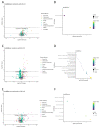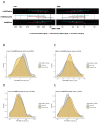Maternal Diet Associates with Offspring Bone Mineralization, Fracture Risk and Enamel Defects in Childhood and Influences the Prenatal Effect of High-Dose Vitamin D Supplementation
- PMID: 38337692
- PMCID: PMC10856831
- DOI: 10.3390/nu16030405
Maternal Diet Associates with Offspring Bone Mineralization, Fracture Risk and Enamel Defects in Childhood and Influences the Prenatal Effect of High-Dose Vitamin D Supplementation
Abstract
We previously demonstrated a beneficial effect of high-dose vitamin D in pregnancy on offspring bone and dental health. Here, we investigated the effect of maternal dietary patterns during pregnancy on the risk of bone fractures, bone mineralization and enamel defects until age 6 years in the offspring. Further, the influence of diet on the effect of high-dose vitamin D was analyzed in the COPSAC2010 mother-child cohort including 623 mother-child pairs. A weighted network analysis on FFQs revealed three specific maternal dietary patterns that associated (Bonferroni p < 0.05) with both offspring bone and dental health. The effect of prenatal high-dose (2800 IU/day) vs. standard-dose (400 IU/day) vitamin D on offspring bone mineral content (adjusted mean difference (aMD): 33.29 g, 95% CI: 14.48-52.09, p < 0.001), bone mineral density (aMD: 0.02 g/cm2 (0.01-0.04), p < 0.001), fracture risk (adjusted incidence rate ratio: 0.36 (0.16-0.84), p = 0.02), and enamel defects in primary (adjusted odds ratio (aOR): 0.13 (0.03-0.58), p < 0.01) and permanent molars (aOR: 0.25; (0.10-0.63), p < 0.01) was most pronounced when mothers had lower intake of fruit, vegetables, meat, eggs, sweets, whole grain, offal and fish. This study suggests that prenatal dietary patterns influence offspring bone and dental development, and should be considered in order to obtain the full benefits of vitamin D to enhance personalized supplementation strategy.
Keywords: bone health; dental health; pregnancy diet; vitamin D.
Conflict of interest statement
All authors declare no potential, perceived, or real conflicts of interest regarding the content of this manuscript.
Figures






Similar articles
-
Effect of High-Dose vs Standard-Dose Vitamin D Supplementation in Pregnancy on Bone Mineralization in Offspring Until Age 6 Years: A Prespecified Secondary Analysis of a Double-Blinded, Randomized Clinical Trial.JAMA Pediatr. 2020 May 1;174(5):419-427. doi: 10.1001/jamapediatrics.2019.6083. JAMA Pediatr. 2020. PMID: 32091548 Free PMC article. Clinical Trial.
-
High-dose vitamin D supplementation in pregnancy and 25(OH)D sufficiency in childhood reduce the risk of fractures and improve bone mineralization in childhood: Follow-up of a randomized clinical trial.EClinicalMedicine. 2021 Dec 24;43:101254. doi: 10.1016/j.eclinm.2021.101254. eCollection 2022 Jan. EClinicalMedicine. 2021. PMID: 35005585 Free PMC article.
-
Effect of maternal prenatal and postpartum vitamin D supplementation on offspring bone mass and muscle strength in early childhood: follow-up of a randomized controlled trial.Am J Clin Nutr. 2022 Mar 4;115(3):770-780. doi: 10.1093/ajcn/nqab396. Am J Clin Nutr. 2022. PMID: 34849536 Free PMC article. Clinical Trial.
-
Effects of vitamin D supplementation during pregnancy on bone health and offspring growth: A systematic review and meta-analysis of randomized controlled trials.PLoS One. 2022 Oct 13;17(10):e0276016. doi: 10.1371/journal.pone.0276016. eCollection 2022. PLoS One. 2022. PMID: 36227906 Free PMC article.
-
Prenatal influences on bone health in children.Expert Rev Endocrinol Metab. 2019 May;14(3):193-202. doi: 10.1080/17446651.2019.1607727. Epub 2019 Apr 26. Expert Rev Endocrinol Metab. 2019. PMID: 31023107 Review.
Cited by
-
Roles of calcium in ameloblasts during tooth development: A scoping review.J Taibah Univ Med Sci. 2024 Dec 30;20(1):25-39. doi: 10.1016/j.jtumed.2024.12.010. eCollection 2025 Feb. J Taibah Univ Med Sci. 2024. PMID: 39839572 Free PMC article. Review.
References
-
- Schroth R.J., Christensen J., Morris M., Gregory P., Mittermuller B.A., Rockman-Greenberg C. The Influence of Prenatal Vitamin D Supplementation on Dental Caries in Infants. J. Can. Dent. Assoc. 2020;86:k13. - PubMed
-
- van der Tas J.T., Elfrink M.E.C., Heijboer A.C., Rivadeneira F., Jaddoe V.W.V., Tiemeier H., Schoufour J.D., Moll H.A., Ongkosuwito E.M., Wolvius E.B., et al. Foetal, neonatal and child vitamin D status and enamel hypomineralization. Community Dent. Oral. Epidemiol. 2018;46:343–351. doi: 10.1111/cdoe.12372. - DOI - PMC - PubMed
MeSH terms
Substances
Grants and funding
LinkOut - more resources
Full Text Sources
Medical

